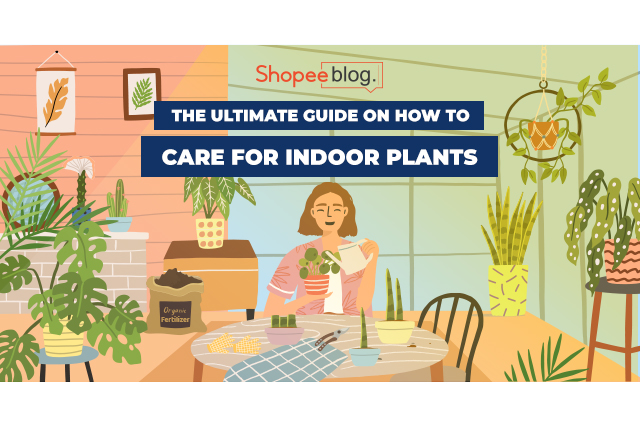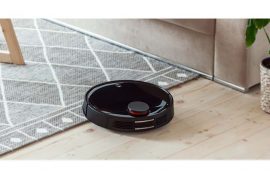Hey new plant parents! How has your journey been so far in caring for your plant babies? Surely you’ll agree that being a plant parent is challenging yet fulfilling at the same time! Seeing your plant babies grow and thrive at home is a simple joy to have. Caring for your indoor plants requires you to give all the love, care, and attention that you can muster up! If you’ve been looking for the ultimate guide on how to care for indoor plants, then we’re glad you stumbled upon this article. Read on to find out all the things you need to know so you can be the best plant parent to your plants!
Watering Indoor Plants
Credit: Cottonbro / Pexels
Watering plants may be a tricky task, especially if you’re a first-time plant parent. If you already have a watering can, then you’re headed towards the right direction. As a newbie plant parent, you might have few questions that you desperately need answers to. So we’ve answered some frequently asked questions to help you out!
1. How much water do my plants need?
Your indoor plants need water just as much as you do! Just like humans, the amount of water needed by each indoor plant varies. This depends on a few factors like the size of the pot it’s in and how much sunlight it gets daily. Plants in bigger pots dry out slower than those in smaller pots. Also, the more direct and brighter the sunlight your plant gets, the faster it will dry out. Make sure to keep these in mind!
When thinking of the amount of water for your plant, you also have to consider the natural environment it thrives in. Desert plants like succulents and cacti thrive in dry environments. So, they don’t need that much water compared to most plants. Plus, the intervals between each watering will be much longer. If your plant’s natural environment is in a place that often gets a lot of rain, then the plant would surely enjoy a lot of water. Let it drink up! For others, their rule of thumb is to water your plants with the amount that measures up to 1/4 of the pot your plant is in.
2. When should I water my plants?
Knowing when to water your plants is a skill that every plant parent needs to master. To easily know if your plant needs water, stick your finger at least 2 inches deep into the soil if your pot is small or medium in size. For plants in bigger pots, stick your finger in at least ⅓ of the soil If there is soil on your finger upon taking it out, then it means it’s still moist and wet enough for your plant. You can then hold off on the watering. If it’s dry, then you need to water your plant right away. Another indication that your plant needs water is if its leaves are wilting. If the soil is dry, your plant’s roots will be dry too. If the roots are dry, then water will come from the leaves instead, causing it to wilt.
The best time of day to water your plants depends on you too! For most plant parents, they prefer to water their plants in the morning. Doing so will prevent it from sitting in extremely wet soil. This is thanks to the morning sunlight!
3. What else do I have to watch out for?
As plant parents, it’s a definite must to put your plants in a pot with a drainage hole. Without it, water won’t drain and this will result in root rot. Once your plant gets root rot, it will only be a matter of time before it dies. You wouldn’t want that for your plant baby! Having a drainage hole in the pot will allow the excess water to drain, preventing root rot.
Another thing to take note of is the temperature of the water you’re giving to your plants. Most plants love warm water, not cold! Warm water is also your best bet because it absorbs better into soil. For plants who love humid environments, make sure that they’re not placed in a room with low humidity. If that’s the case, then you will have to water them more frequently. This is because being in low humidity will make the plant lose water a lot quicker. A trick that you can also do is to place your indoor plants close to each other. This will allow them to share each other’s humidity.
Sunlight for Indoor Plants
Credit: Behzad Ghaffarian / Unsplash
If you’ve read The Ultimate Guide to Buying Indoor Plants article, you’d see that we briefly touched on the sunlight aspects when it comes to caring for your indoor plants. Remember: light is food for plants! Before you buy your indoor plant, make sure to research well about what that plant needs. The amount of sunlight plants need varies. Keep reading to find out the answers to questions you’ve probably been pondering about!
1. How do I differentiate the different kinds of light?
If “bright light”, “medium light”, and “low light” still confuse you, then do the simple shadow test to find out for sure! Simply get a piece of white, blank paper and put it in the spot where you plan to put your plant. This is best done during midday. Then, put your hand above the paper. If the shadow of your hand on the paper is sharp and defined, then it’s bright light. If it has a softer shadow, then it’s medium light. For plants that require low light, put it a few feet away from the window where sunlight comes in. It’s just as easy as that!
2. How do I know if my plant is getting enough sunlight?
One thing to always remember is that your plant will show you what it needs. It gives off signs so you will be able to tell what it needs. If its leaves are brown and starting to wilt, then most often that not, it means it’s getting too much sunlight. Move it to a different spot right away. Don’t let it reach the point where its leaves “burn” because of too much sunlight. On the other hand, if your plant is not getting adequate sunlight, it will start to look for it. In this case, its stems will stretch out in search of sunlight. This is bad news because once your plant undergoes extended growth, it won’t be able to recover.
Fertilizing Indoor Plants
Credit: Cottonbro / Pexels
1. What is a fertilizer for?
You’ve probably heard of fertilizing plants. The pro tip in fertilizing is that you have to remember that it’s just a supplement. Much like how taking vitamins will give you an extra boost. Over time, your plant’s soil will lose its minerals, so adding fertilizer will provide more for your plants.
2. When do my plants need fertilizer?
Remember that you don’t have to do it regularly! Once a year is good enough for your plants. If you have indoor plants that grow fast, it needs fertilizer more often than those that don’t grow quickly. On top of that, plants that bear fruits and/or flowers need fertilizers more often too! For low-light plants and recently potted ones, these don’t require fertilizers.
Propagating Indoor Plants
Credit: Huy Phan / Pexels
Propagating is probably the most challenging way of caring for your plants. Despite the challenges it brings, the satisfaction you’ll get when it successfully propagates will be worth it. How do you propagate, you may ask? Grab your pruning shears and let’s get started! Scissors will do the job too.
First off, choose the plant that you want to propagate. If this is your first time doing it, we suggest trying out propagating plants that have nodes. These kinds of plants are usually easier to propagate. Pothos plants are great options! They have a lot of leaves so you wouldn’t mind snipping away a few. Philodendron plants can easily be propagated too! Once you’ve chosen either plant, look for a brown root node in your plant’s stem. When you find one, cut a few inches below the node. After doing so, plant the newly cut stem with the node in soil. You have the option of putting it in water too! But most plants grow better in soil. This is mostly because the nutrients your plant needs are in soil, not water. Once you plant the stem, don’t water it right away. Give it a few days to properly settle in its new home. All you have to do now is to be patient and cross your fingers hoping your plant will survive and thrive!
All these tips in caring for indoor plants may be overwhelming, but practice makes perfect. Give yourself room to make errors! You’ll eventually get the hang of caring for your indoor plants. It will come like second nature to you. Just make sure to pay close attention to your plant. It never lacks in showing you signs and symptoms regarding its needs! As plant parents, you only want what’s best for your plant babies. Let it drink up when it’s thirsty, bathe it in the right amount of sunlight, fertilize it once a year if needed, and propagate it for more plant babies. Do all those and you’re set to become plant parent of the year!









